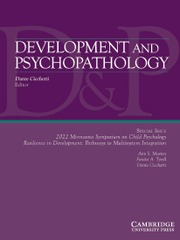Crossref Citations
This article has been cited by the following publications. This list is generated based on data provided by
Crossref.
French, Doran C.
and
Dishion, Thomas J.
2003.
Predictors of Early Initiation of Sexual Intercourse among High-Risk Adolescents.
The Journal of Early Adolescence,
Vol. 23,
Issue. 3,
p.
295.
Dishion, Thomas J
Owen, Lee D
and
Bullock, Bernadette M
2004.
Like father, like son: Toward a developmental model for the transmission of male deviance across generations.
European Journal of Developmental Psychology,
Vol. 1,
Issue. 2,
p.
105.
Hay, Dale F.
Payne, Alexandra
and
Chadwick, Andrea
2004.
Peer relations in childhood.
Journal of Child Psychology and Psychiatry,
Vol. 45,
Issue. 1,
p.
84.
van Boxtel, Herman W
Orobio de Castro, Bram
and
Goossens, Frits A
2004.
High self-perceived social competence in rejected children is related to frequent fighting.
European Journal of Developmental Psychology,
Vol. 1,
Issue. 3,
p.
205.
Ellickson, Phyllis L.
D'Amico, Elizabeth J.
Collins, Rebecca L.
and
Klein, David J.
2005.
Marijuana Use and Later Problems: When Frequency of Recent Use Explains Age of Initiation Effects (and When It Does Not).
Substance Use & Misuse,
Vol. 40,
Issue. 3,
p.
343.
Dishion, Thomas J.
Nelson, Sarah E.
and
Yasui, Miwa
2005.
Predicting Early Adolescent Gang Involvement From Middle School Adaptation.
Journal of Clinical Child & Adolescent Psychology,
Vol. 34,
Issue. 1,
p.
62.
Rhule, Dana M.
2005.
Take Care to Do No Harm: Harmful Interventions for Youth Problem Behavior..
Professional Psychology: Research and Practice,
Vol. 36,
Issue. 6,
p.
618.
Flouri, Eirini
2005.
Psychological and Sociological Aspects of Parenting and Their Relation to Suicidal Behavior.
Archives of Suicide Research,
Vol. 9,
Issue. 4,
p.
373.
Boxer, Paul
Guerra, Nancy G.
Huesmann, L. Rowell
and
Morales, Julie
2005.
Proximal Peer-Level Effects of a Small-Group Selected Prevention on Aggression in Elementary School Children: An Investigation of the Peer Contagion Hypothesis.
Journal of Abnormal Child Psychology,
Vol. 33,
Issue. 3,
p.
325.
de Kemp, Raymond A. T.
Scholte, Ron H. J.
Overbeek, Geertjan
and
Engels, Rutger C. M. E.
2006.
Early Adolescent Delinquency.
Criminal Justice and Behavior,
Vol. 33,
Issue. 4,
p.
488.
Bloor, Roger
2006.
The Influence of Age and Gender on Drug Use in the United Kingdom—A Review.
The American Journal on Addictions,
Vol. 15,
Issue. 3,
p.
201.
MacIntyre, James C.
Essock, Susan
Clay, Sally
Zuber, Michael P.
and
Felton, Chip J.
2006.
The Kids Oneida Project: What Happened to Services When the Payment Rules Changed.
Administration and Policy in Mental Health and Mental Health Services Research,
Vol. 33,
Issue. 5,
p.
585.
HAY, DALE F.
2007.
The gradual emergence of sex differences in aggression: alternative hypotheses.
Psychological Medicine,
Vol. 37,
Issue. 11,
p.
1527.
Steenbeek, Henderien W.
and
van Geert, Paul L.C.
2007.
A theory and dynamic model of dyadic interaction: Concerns, appraisals, and contagiousness in a developmental context.
Developmental Review,
Vol. 27,
Issue. 1,
p.
1.
de Castro, Bram Orobio
Brendgen, Mara
Van Boxtel, Herman
Vitaro, Frank
and
Schaepers, Linda
2007.
“Accept Me, or Else…”: Disputed Overestimation of Social Competence Predicts Increases in Proactive Aggression.
Journal of Abnormal Child Psychology,
Vol. 35,
Issue. 2,
p.
165.
Ainsworth, Frank
2007.
Residential programs for children and young people: What we need and what we don’t need.
Children Australia,
Vol. 32,
Issue. 1,
p.
32.
Bowman, Marvella A.
Prelow, Hazel M.
and
Weaver, Scott R.
2007.
Parenting Behaviors, Association with Deviant Peers, and Delinquency in African American Adolescents: A Mediated-Moderation Model.
Journal of Youth and Adolescence,
Vol. 36,
Issue. 4,
p.
517.
Ruffolo, Mary C.
and
Allen‐Meares, Paula
2008.
Comprehensive Handbook of Social Work and Social Welfare.
Steenbeek, Henderien
and
Van Geert, Paul
2008.
An empirical validation of a dynamic systems model of interaction: do children of different sociometric statuses differ in their dyadic play?.
Developmental Science,
Vol. 11,
Issue. 2,
p.
253.
2008.
Social Competence with Peers in Third Grade: Associations with Earlier Peer Experiences in Childcare1.
Social Development,
Vol. 17,
Issue. 3,
p.
419.

